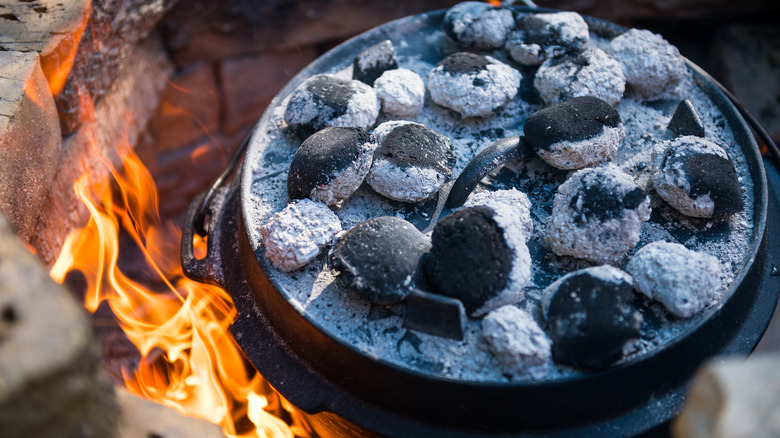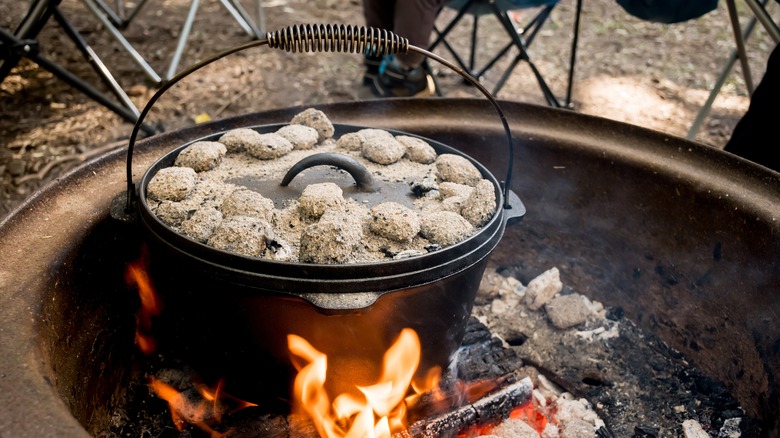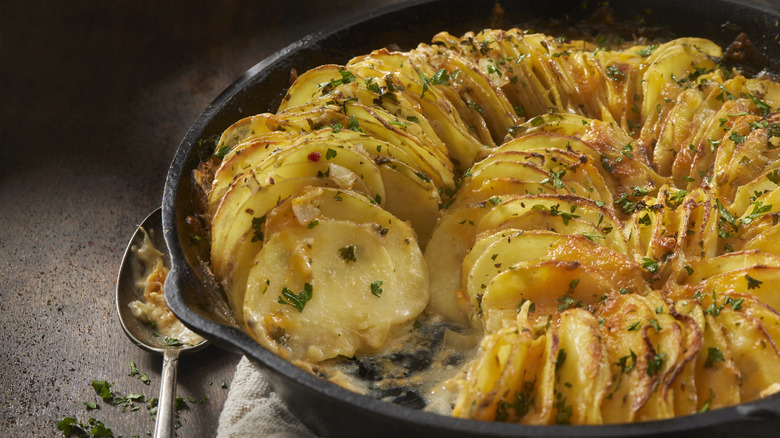Dutch-Oven Potatoes Are The Idaho Classic Fit To Feed A Party
As clichéd as it might seem to outsiders, Idaho really is all about its potatoes. It is a billion-dollar industry in the state, and the crop is renowned throughout the world for its quality and proliferation. As connected as Idaho is to this beloved tuber, the question must be asked: how do Idahoans prefer to cook their potatoes? The answer: In a Dutch oven.
Dutch-oven potatoes are an Idaho tradition. A common sight at dinner tables, cookouts, camping trips, and holidays, Dutch-oven potatoes are one of those meals that nearly every Idahoan knows how to make. Though recipes likely differ from family to family, the basics remain the same: You take heavily seasoned, thinly sliced potatoes and cook them in a cast iron Dutch oven over an open flame.
Seeing as Idaho was once part of the "untamed west" filled with ranchers and campers, outdoor cooking was once a part of everyday life. Dutch ovens became an integral tool in America's westward expansion, as they could be transported easily and be used to make any number of different recipes. These days, you don't need to go out into the wilds of Idaho to replicate Dutch-oven potatoes in your kitchen, though plenty do still cook them using a campfire. The meal is easily adaptable to other cooking vessels, heat sources, and ingredients. But first, you ought to know exactly what Dutch-oven potatoes are.
What are Dutch-oven potatoes?
Think of Dutch-oven potatoes as the Idaho version of potatoes au gratin. The classic au gratin recipe consists of thinly sliced potato semi-circles arranged in a dish, baked in cream, and topped with cheese. Dutch-oven potatoes take a similar approach, though the primary cooking tool is a cast iron Dutch oven, one that can easily withstand the heat of the traditional campfire heat source.
The recipe begins with the spuds — traditionally Russets, Idaho's star potato. They are sliced thinly and layered into the Dutch oven, no peeling necessary. Along with the potatoes go chopped onions and bacon. Everything is seasoned with salt, pepper, and some garlic powder, before being coated in either chicken stock, cream, or cream of mushroom soup for added moisture.
The Dutch oven is covered and set atop a bed of campfire coals, which form a ring around the base of the pot. More coals are shoveled on top of the pot lid to create a pseudo oven and provide heat from above. Cooking time is really up in the air when the potatoes are made this way. Working with coals and campfires can be tricky as temperatures are often difficult to regulate. You will need to be vigilant. Stir and check the potatoes for tenderness every so often. Once they can be easily pierced with a fork, shredded cheese goes on top, and everything is baked for a few more minutes until the cheese is melted and bubbly.
Substitutions and shortcuts
As much fun as cooking Dutch-oven potatoes outside may be, compromises have to be made in order to cook the dish in the comfort of your own kitchen. Chief among these compromises are the cooking vessel and the heat source. Not everyone owns a cast iron Dutch oven, though it is undoubtedly the right tool for the job due to its excellent heat retention and distribution. Any oven-safe pot or casserole dish will do, and a 350 F oven will more than suffice as a substitute for hot coals. Plus, you'll have better control as far as cooking time and temperature are concerned.
You should stick with the core ingredients: potatoes, bacon, and onions. You can swap Russets for smaller new potatoes and use leeks instead of or in addition to onions. Mushrooms, herbs like parsley or oregano, and liquids like chicken stock, wine, beer, or cream will all work here. Cheddar is the preferred option as far as cheese goes, but you could also opt for tangy Swiss cheese, Gruyère, or even mozzarella.
Remember, there is no set recipe for Dutch-oven potatoes. As long as you don't stray too far from potatoes, bacon, and onions as your base, you can add any number of extra flavors to suit your preferences. Just make sure you do it the Idaho way and make enough for a party.


